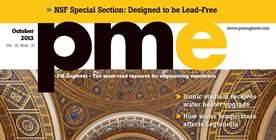 Updated on October 22, 2021.
Updated on October 22, 2021.
At first glance, guidelines may lead engineers and facility operators to conclude that controlling Legionella bacteria in plumbing (domestic/potable water) systems can be accomplished long-term by simply raising water heater temperatures.
As with any solution that appears easy and cheap, it is important to check the fine print.
First, understand that water temperatures are just a small part of a comprehensive Legionella water management plan.
Second, understand the limitations of water temperatures in controlling Legionella. Increasing hot water temperatures may not be an option because of regulations. Mixing valves may help with Legionella control in some systems but not in others. And, reducing cold water temperatures may be infeasible or impractical.
Third, don’t assume Legionella control based on temperatures. Even if water can be maintained within the temperature range typically recommended for Legionella control, the results for real plumbing systems will very likely be different than the results for the piping loops set up for the laboratory studies on which the recommended ranges were based.
Water temperature management must be given its proper place within a Legionella water management program – no more and no less. Target temperatures must be set thoughtfully, achieved safely, and measured. As with the entire Legionella water management plan, the effectiveness of water temperatures in controlling Legionella cannot be guaranteed and must therefore be validated rather than assumed.
For more on this topic, see the article “The Fine Print” (PM Engineer, October) on https://hcinfo.com/publications/free-legionella-articles/, and the online training course, “Water Temperatures and Legionella in Plumbing Systems.” If you have access to LAMPS Training Notes, see 4.009, “Domestic Water Temperatures.”
Have you had success in in controlling Legionella in domestic water systems via water temperatures management? Please comment to share your experience.

